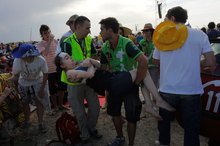When facing the imminent death of a loved one, you may wonder how you’ll know when the end is near. As the body begins the process of shutting down, certain changes take place in bodily and mental functions. It may take less than a day or as long as a couple of weeks for your loved one to complete the dying process. By recognizing the signs of impending death, you can be better prepared to say your goodbyes and to help others deal with their loss.
Food and Fluid Intake
The dying person loses interest in food and fluid as death approaches. Food and fluids may be difficult for the body to metabolize at this stage, because the person’s organ systems are slowing. The Merck Manual for Health Care Professionals says that dehydration and caloric restriction can actually ease discomfort rather than cause it 1. A dry mouth can be an irritation as fluid intake ceases, but that can be relieved with moist swabs or ice chips if the person is conscious. (see reference #1)
Breathing Changes
Signs That a Cancer Patient Is at the End of Life
Learn More
As death approaches, breathing becomes more shallow, and the breathing rate may increase or decrease. There may be gaps between breaths that become longer and longer until breathing stops. The dying person becomes unable to swallow saliva, which pools at the back of the throat and in the bronchi. When the person breathes, the air passing over and through the saliva causes a rattling sound, commonly referred to as a death rattle. While the sound is often distressing to loved ones, the Merck Manual for Health Care says the death rattle causes no discomfort to the dying person 1. (see reference #1)
- As death approaches, breathing becomes more shallow, and the breathing rate may increase or decrease.
- When the person breathes, the air passing over and through the saliva causes a rattling sound, commonly referred to as a death rattle.
Decreased Urine
Urine output decreases and eventually stops as a person gets closer to death. The International Network for Cancer Treatment and Research, or INCTR, says this occurs because the heart can no longer adequately pump blood through the body, leading the kidneys to begin shutting down. Another reason for decreased urine output is that fluid intake is usually reduced. (see reference #2)
- Urine output decreases and eventually stops as a person gets closer to death.
Decreased Circulation
End of Life Symptoms of Stage IV Melanoma
Learn More
Blood circulation decreases in the dying person. Hands and feet may become cool to the touch. The INCTR says the tip of the nose, nail beds and knees may appear blue or purple due to lack of oxygenation. The extremities often show signs of mottling--a purple, blotchy appearance due to decreased circulation. Lack of a pulse in the wrist can mean that death will occur in a few hours. (see reference #2)
- Blood circulation decreases in the dying person.
- The INCTR says the tip of the nose, nail beds and knees may appear blue or purple due to lack of oxygenation.
Confusion and Loss of Consciousness
A dying person tends to be drowsy, sleeps more and may seem disconnected from family and friends. They can become confused and not know where they are or who a loved one is. The National Cancer Institute says it is not uncommon for dying people to have hallucinations or see visions of those who have died before them 3. Often when death is near, the dying person become unresponsive and slips into a coma-like state. It is believed that even in this unresponsive state, however, people can still hear those who speak to them. (see reference #3)
Related Articles
References
- The Merck Manual for Health Care Professionals: Symptom Relief for the Dying Patient
- INCTR Palliative Care Handbook: Signs and Symptoms at the End of Life
- National Cancer Institute: End-of-Life Care for People Who Have Cancer
- Maxfield M, Bevan A. Aging and Coping With Mortality. Handbook of Terror Management Theory. 2019:391-415. doi:10.1016/B978-0-12-811844-3.00017-2
- Lekalakala-Mokgele E. Death and dying: Elderly persons’ experiences of grief over the loss of family members. South African Family Practice. 2018;60(5):151-154. doi:10.1080/20786190.2018.1475882
- Cicirelli V. Death Attitudes and the Older Adult. (Tomer A, ed.). Psychology Press; 2000:187-189.
- Kearl MC. Endings. New York: Oxford University Press; 1989:24-34.
- National Institute on Aging. Providing Care and Comfort at the End of Life. Updated May 17, 2017.
- The American Cancer Society medical and editorial content team. What To Expect When A Person With Cancer Is Nearing Death. American Cancer Society. Updated May 10, 2019.
- World Health Organization (WHO), Canadian Blood Services. International Guidelines for the Determination of Death – Phase I. WHO Patient Safety. Published May 2013.
- Wisman A, Shrira I. The smell of death: Evidence that putrescine elicits threat management mechanisms. Front Psychol. 2015;6. doi:10.3389/fpsyg.2015.01274
- Harvard Health. Beyond The Five Stages of Grief. Harvard Health Publishing, Harvard Medical School. Published December 2011.
- Kübler-Ross E. On Death and Dying. New York: Simon and Schuster; 2011:37-133. 9781451664447
- Widera EW, Block SD. Managing grief and depression at the end of life. Am Fam Physician. 2012;86:259–264.
- The American Cancer Society medical and editorial content team. Grief and Bereavement. American Cancer Society. Updated May 10, 2019.
- Borgstrom E. Social death. QJM. 2017;110(1):5-7. doi:10.1093/qjmed/hcw183
- Kübler-Ross E. Living with Death and Dying. New York: Simon and Schuster; 2011.
- Pessin H, Fenn N, Hendriksen E, DeRosa AP, Applebaum A. Existential distress among healthcare providers caring for patients at the end of life. Curr Opin Support Palliat Care. 2015;9(1):77-86. doi:10.1097/SPC.0000000000000116
- Butler K. The Art of Dying Well. New York: Scribner; 2020.
- McDarby M. Older Adults and Palliative and End-of-Life Care Fact Sheet. American Psychological Association.
- Oates JR, Maani CV. Death and Dying. In: StatPearls [Internet]. Treasure Island (FL): StatPearls Publishing; 2020. Updated December 12, 2019.
- Stillion J. Death, Dying, and Bereavement. New York: Springer Publishing Company; 2014.
Writer Bio
Christy Brogan is a nurse specializing in the fields of oncology, hospice and home care who has written educational materials for patients and students locally. She has been a clinical instructor teaching both patients and nursing students about health care issues. She graduated from Grand View College in 2005 with her Bachelor of Science in nursing.








